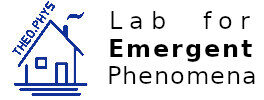Master thesis – Johannes Hielscher
Johannes Hielscher
Circular Dichroism of Distorted Structure-Photonic Materials
[PDF]
finished 2015-03
supervised by Gerd Schröder-Turk and Matthias Saba
Abstract
The single Gyroid is a triply periodic negative curvature surface of BCC cubic symmetry, frequently occurring in nature, e. g. in the wing scales of the butterfly Callophrys rubi. Within there, it gives rise to structural colour (Simulation parameters are chosen to meet experimental data, to easily embed the work into the context of bio-photonics). The inevitable deviations of biological systems from perfect periodic order, as well as the possible tolerances for synthetic photonic devices adopting Gyroid structures, will motivate the main question of this work: the influence of distortion on the Gyroid’s photonic properties. The Gyroid is a handed (chiral) structure, so a natural question is its response to handed light (circular polarisation, CP). As an approach to quantify chiro-optical behaviour, we will introduce and discuss the Cumulative Circular Contrast (CCR) as an appropriate, setup-conscious way to measure CP-light response of media in slab-like geometry. We will give a comprehensive overview of three distinct Gyroid construction routes: Nodal approximation to TPMS/CMC, 1srs network graph with finite wire thickness, and assembly from discrete helices, each including analysis of volume filling fraction and characteristic length scales. A Fourier synthesis approach for a distortion field with finite correlation scales will be developed, and deployed to create geometries derived from the Gyroid via controlled distortion. On these, FDTD simulations are carried out, to measure reflectance and transmission. Additionally, systems with finite absorption or at non-normal incident angle will be included into comparisons. The ranges of distortion correlation will be probed and discussed, with a focus on the Cartesian [001] direction of the Gyroid: Short correlations (high-frequency “structural noise”) give rise to smearing-out and to partial loss in circular contrast. Long-wavelength distortions, however (resembling a chirp, i. e. pitch gradient throughout the slab), will be found to influence the coupling behaviour, with a pronounced sensitivity of transmission enhancement on the pitch/density gradient. The helical model of the Gyroid is “disassembled” into its uniaxial subsets, and a separability of the characteristic reflectance behaviour by the helix orientation relative to the incident light is observed.
The single Gyroid is a triply periodic negative curvature surface of BCC cubic symmetry, frequently occurring in nature, e. g. in the wing scales of the butterfly Callophrys rubi. Within there, it gives rise to structural colour (Simulation parameters are chosen to meet experimental data, to easily embed the work into the context of bio-photonics). The inevitable deviations of biological systems from perfect periodic order, as well as the possible tolerances for synthetic photonic devices adopting Gyroid structures, will motivate the main question of this work: the influence of distortion on the Gyroid’s photonic properties. The Gyroid is a handed (chiral) structure, so a natural question is its response to handed light (circular polarisation, CP). As an approach to quantify chiro-optical behaviour, we will introduce and discuss the Cumulative Circular Contrast (CCR) as an appropriate, setup-conscious way to measure CP-light response of media in slab-like geometry. We will give a comprehensive overview of three distinct Gyroid construction routes: Nodal approximation to TPMS/CMC, 1srs network graph with finite wire thickness, and assembly from discrete helices, each including analysis of volume filling fraction and characteristic length scales. A Fourier synthesis approach for a distortion field with finite correlation scales will be developed, and deployed to create geometries derived from the Gyroid via controlled distortion. On these, FDTD simulations are carried out, to measure reflectance and transmission. Additionally, systems with finite absorption or at non-normal incident angle will be included into comparisons. The ranges of distortion correlation will be probed and discussed, with a focus on the Cartesian [001] direction of the Gyroid: Short correlations (high-frequency “structural noise”) give rise to smearing-out and to partial loss in circular contrast. Long-wavelength distortions, however (resembling a chirp, i. e. pitch gradient throughout the slab), will be found to influence the coupling behaviour, with a pronounced sensitivity of transmission enhancement on the pitch/density gradient. The helical model of the Gyroid is “disassembled” into its uniaxial subsets, and a separability of the characteristic reflectance behaviour by the helix orientation relative to the incident light is observed.
